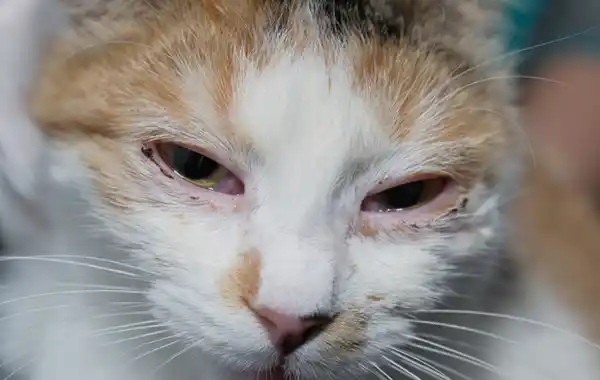Cats use their eyes for much more than just vision. Whether greeting you with a slow blink or psyching out the neighbour’s cat with a ‘death stare’, their eyes really are a window to the soul. Healthy cats’ eyes should look clear and bright, with equal-sized pupils. If your cat’s eyes look different to normal, it’s a good idea to book a check-up with your vet.
Conjunctivitis is one of the most common eye conditions we treat. Any word ending in ‘itis’ means inflammation; conjunctivitis is when the conjunctivae (thin membrane lining the eyelids) are inflamed.
What are the signs of conjunctivitis?
Eyes are complex pieces of engineering; if one part malfunctions, other parts react and become inflamed. Conjunctivitis can sometimes indicate a problem deep within the eye.
A small amount of discharge at the corner of your cat’s eyes is normal but sticky gunk isn’t!
Cats with conjunctivitis:
- Blink or squint more.
- Have pink, sticky, crusty eye(s), and their cornea may look cloudy.
- Rub and paw their face.
- Often seem generally unwell.
What causes conjunctivitis?
Your vet needs to establish the underlying cause to make sure your cat gets the right treatment:
Infectious causes
Cat flu — this is a respiratory illness caused by viruses (feline herpesvirus and calicivirus) and bacteria (chlamydophila). Most cats show more than one symptom of cat flu.
Non-infectious causes
Foreign bodies — vets pull all sorts out of eyes including grass seeds, blades of grass,
and cat claws. Left untreated, these objects rub on the front of the eye and cause painful corneal ulceration (open sores on the clear, front part of the eye).
Eyelid conditions — growths on the eyelid affect normal eye function, as do droopy (ectropion) or in turned (entropion) eyelids.
Blockages to tear ducts — these can cause eyes to dry out and become sore.
Eyelashes — if they are growing in the wrong place or direction they can irritate the eye.
Glaucoma — this is a fluid build-up within the eye causing high pressure and pain.
Cats with allergic skin disease or those exposed to irritants (smoke, sand, strong air fresheners) are more likely to develop conjunctivitis.
Treatment
The treatment your vet prescribes will depend on the underlying cause of your cat’s conjunctivitis. For uncomplicated conjunctivitis, your cat may need:
- Topical antibiotic drops.
- False tears (to moisturise eyes).
- Anti-inflammatory drops.
You can bathe your cat’s eye(s) with cotton wool and clean, warm water. It’s highly unlikely you’ll catch your cat’s conjunctivitis but, just in case, wash your hands after touching your cat’s eyes.







